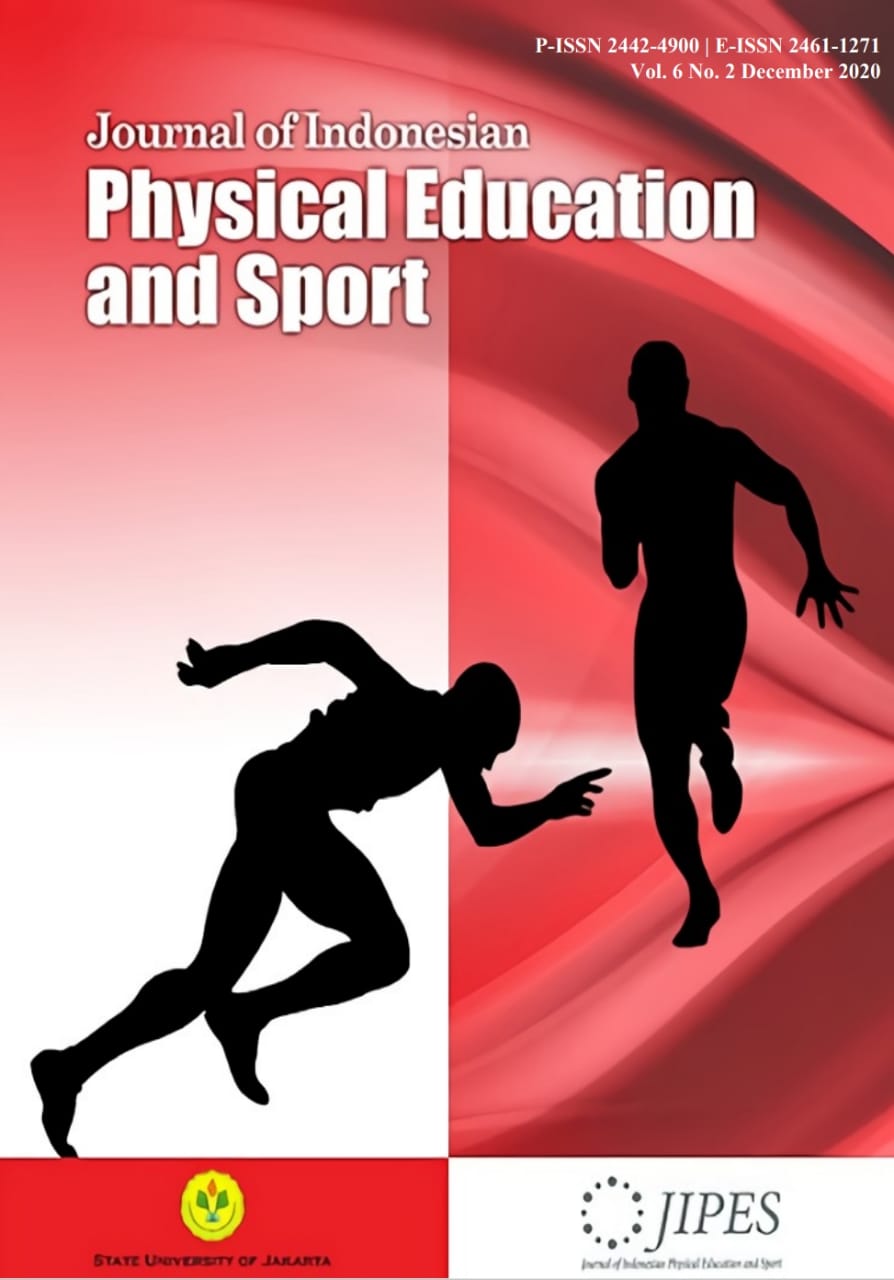SELF-EFFICACY SCALE VALIDATION AMONG FOOTBALL PLAYERS (ALGERIA)
DOI:
https://doi.org/10.21009/JIPES.062.03Keywords:
self-efficacy, self-efficacy scale, football playersAbstract
The purpose of this study was to adapt the Algerian football players of general self-efficacy scale (GSES) developed by Schwarzer & Jerusalem (1995) which were adapted into more than thirty-three languages. The study conducted on a total of 216 male football players, ranging in age from 15-18 years. After translating the scale according to the local language, it was presented to specialists in psychology and sports psychology to formulate it to suit the applied category. the principal components analysis with varimax rotation was used for the construct validity.The results indicated that there are two-factor structure, the two factors together explained 54.5 % of the total variance. The reliability scales were found by Alpha Cronbach coefficient (0.79). These results confirmed that the self-efficacy scale among football players valid and reliable. It is necessary to conduct future studies in the local culture and on different sports and ages.
References
2.McAuley, E. Self-referent thought in sport and physical activity. In T. S. Horn (ed.), Advances in Sport Psychology, (pp. 101-118). Champaign, IL: Human Kinetics;1992.
3.McAuley, E., & Mihalko, S. L. Measuring exercise-related self-efficacy. In J. L.Duda (Ed.), Advancements in sport and exercise psychology measurement (pp. 371-390).Morgantown, WV: Fitness Information Technology;1998.
4.O'Leary, A. Self-efficacy and health. Behavior research and therapy, 1982;23(4), 437-451. DOI:10.1016/0005-7967(85)90172-x
5.Feltz DL. Self-confidence and sports performance. In K. B. Pandolf (Ed.) Exercise and Sport Sciences Reviews, (pp. 423-457). New York: MacMillan ;1988.
6.Bandura, A. Social foundations of thought and action: a social cognitive theory. Englewood Cliffs, N.J.: Prentice-Hall;1986.
7.Bandura, A. Self-efficacy mechanism in human agency. Journal of American psychology,1982 ; 37(2),122-147. https://doi.org/10.1037/0003-066X.37.2.122
8.Decamps ,G . Sport psychology and performance (1st Ed). Brussels: Boeck Group S.A.2012.
9.Tod,DSport psychology. The basics. (1st Ed), New York: Routledg. 2014.
10.Bandura, A. Self-efficacy. The exercise of control. New York: W.H.Freeman.1997.
11.Maddux, J. Self-efficacy theory: An introduction. In J. Maddux. (Ed.), Self-efficacy adaptation and adjustment: Theory research and application (pp. 3–33). New York, NY: Plenum Press.1995.
12.Gernigon, C., & Delloye, J. Self-efficacy, causal attribution, and track athletic performance following unexpected success or failure among elite sprinters. Sport Psychologist,2003; 17, 55–76. https://psycnet.apa.org/record/2003-02630-005
13.Feltz, D. L., Landers, D. M., & Raeder, U. Enhancing self-efficacy in high-avoidance motor tasks: a comparison of modeling techniques. Journal of Sport and Exercise Psychology,1979; 1, 112–122.
14.Gist, M., & Mitchell, T. Self-efficacy: A theoretical analysis of its determinants and malleability. Academy of Management Review,1992; 17, 183–211. doi:10.5465/AMR.1992.4279530.
15.Hall, C. R., Munroe-Chandler, K. J., Cumming, J., Law, B., Ramsey, R., & Murphy, L. Imagery and observational learning use and their relationship to sport confidence. Journal of Sport Sciences,2009; 27, 327–337. Doi: 10.1080/02640410802549769.
16.SooHoo, S., Takemoto, K., & McCullagh, P. A comparison of modeling and imagery on the performance of a motor skill. Journal of Sport Behavior,2004; 27, 349–366. https://psycnet.apa.org/record/2004-21135-004
17.McAuley, E. Modelling and self-efficacy: A test of Bandura’s model. Journal of Sport Psychology,1985 ; 7,283–295. https://journals.humankinetics.com/view/journals/jsep/7/3/article-p283.xml
18.Villani, D., Caputo, M., Balzarotti, S., & Riva, G. Enhancing self-efficacy through a blended training: A pilot study with basketball players. International Journal of Sport and Exercise Psychology,2015 ; 15(2), 160-175. https://doi.org/10.1080/1612197X.2015.1079921
19.Crain, W. Theories of development: Concepts and applications. (4th Ed.). London: Prentice-Hall.2000.
20.Mamassis, G., & Doganis, G. The effects of a mental training program on junior’s pre- competitive anxiety, self-confidence and tennis performance. Journal of Applied Sport Psychology,2004; 16, 118–137. doi:10.1080/10413200490437903 .
21.Uphill, M. A., McCarthy, P. J., & Jones, M. V. Getting a grip on emotion regulation in sport: Conceptual foundations and practical applications. In S. M. S. Hanton (Ed.), Advances in applied sport psychology: A review (pp. 162–194). Abingdon: Routledge.2008.
22.Schwarzer, R., & Jerusalem, M. Generalized Self-Efficacy scale. In J. Weinman, S. Wright, & M. Johnston, Measures in health psychology: A user’s portfolio. Causal and control beliefs (pp. 35-37). Windsor, UK: NFER-NELSON.1995.
23.Schwarzer, R. Self-efficacy: Thought control of action. Washington, DC: Hemisphere.1992.
24.Rimm, H., & Jerusalem, M. Adaptation and validation of an Estonian version of the General Self-Efficacy Scale (ESES). Anxiety, Stress, and Coping,1999 ; 12, 329-345. https://doi.org/10.1080/10615809908250481
25.Crandall, A., Rahim, H. A., & Yount, K. M. Validation of the general self-efficacy scale among Qatari young women. Eastern Mediterranean Health Journal, 2015 ;21(12), 891-896. DOI:10.26719/2015.21.12.891.
26.Scholz U, Doña BG, Sud S, & Schwarzer, R.Is general self-efficacy a universal construct? Psychometric findings from 25 countries.Eur J Psychol Assess.2002;18(3):242–51. DOI: 10.1027//1015-5759.18.3.242
27. Moritz, S. E., Feltz, D. L., Fahrbach, K. R., & Mack, D. E. The relation of self-efficacy measures to sport performance: A meta-analytic review. Research quarterly for exercise and sport, 2000 ;71(3), 280-294
28.Cheung, S. K., & Sun, S. Y. Assessment of optimistic self-beliefs: further validation of the Chinese version of the General Self-Efficacy Scale. Psychological Reports,1999 ; 85, 1221–1224. https://doi.org/10.2466/pr0.1999.85.3f.1221
29.Leung, D. P., & Leung, A. M. Factor structure and gender invariance of the Chinese general selfefficacy scale among soon-to-be-aged adults. Journal of Advanced Nursing, 2011 ;67(6), 1383–1392. https://onlinelibrary.wiley.com/doi/abs/10.1111/j.1365-2648.2010.05529.x
30.Schwarzer, R., Bäßler, J., Kwiatek, P., Schröder, K., & Zhang, J. X. The assessment of optimistic selfbeliefs: comparison of the German, Spanish, and Chinese versions of the general self‐efficacy scale. Applied Psychology,1997 ; 46(1), 69–88. https://doi.org/10.1111/j.1464-0597.1997.tb01096.x
31.Teo, T., & Kam, C. A measurement invariance analysis of the general self-efficacy scale on two different cultures. Journal of Psychoeducational Assessment, 32(8),2014 ; 762-767. https://doi.org/10.1177/0734282914531707
32.Zhang, J. X., & Schwarzer, R. Measuring optimistic self-beliefs: a Chinese adaptation of the general self-efficacy scale. Psychologia: An International Journal of Psychology in the Orient,1995 ; 38, 174–181. https://psycnet.apa.org/record/1996-35921-001
33.Chiu, F. P., & Tsang, H. W. Validation of the Chinese general self-efficacy scale among individuals with schizophrenia in Hong Kong. International Journal of Rehabilitation Research, 27(2),2004 ; 159–161 10.1097/01.mrr.0000127640.55118.6b
34.Zhou, M. A revisit of general self-efficacy scale: Uni-or multi-dimensional?. Current Psychology, 35(3),2016 ; 427-436. DOI 10.1007/s12144-015-9311-4
35.Aypay, A. The Adaptation Study of General Self-Efficacy (GSE) Scale to Turkish. Inonu University Journal of the Faculty of Education (INUJFE), 11(2).2010 ;https://pegem.net/dosyalar/dokuman/121638-20110630181537-11206.pdf










 </a > a
</a > a 